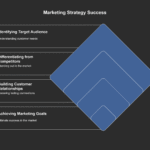In today’s rapidly evolving business landscape, organizations face unprecedented challenges that demand sophisticated strategic planning approaches. The complexity of global markets, technological disruption, and shifting stakeholder expectations requires a systematic methodology that goes beyond traditional planning exercises. This article examines the technical components of effective strategic planning services and their implementation across diverse organizational contexts.
The Strategic Planning Imperative
Strategic planning has evolved from a periodic exercise into a continuous organizational capability. Modern enterprises require dynamic planning frameworks that can adapt to market volatility while maintaining strategic coherence. The traditional five-year planning cycle has given way to more agile approaches that incorporate real-time data analysis, scenario modeling, and iterative strategy refinement.
Organizations that implement robust strategic planning processes demonstrate measurably superior performance outcomes. Research indicates that companies with formalized strategic planning frameworks achieve 12-15% higher revenue growth rates and 20% better operational efficiency compared to their peers. These performance differentials are particularly pronounced in industries experiencing rapid technological change or regulatory evolution.
Core Components of Strategic Planning Services
Environmental Analysis and Market Intelligence
Effective strategic planning begins with comprehensive environmental scanning that captures both macro and micro-level factors influencing organizational performance. This involves systematic analysis of political, economic, social, technological, environmental, and legal (PESTEL) factors, combined with detailed competitive intelligence gathering.
Advanced strategic planning services employ sophisticated analytical tools including Porter’s Five Forces analysis, value chain mapping, and stakeholder influence assessment. These frameworks provide structured approaches to understanding competitive dynamics and identifying strategic opportunities or threats that may not be immediately apparent through conventional analysis.
The integration of big data analytics and artificial intelligence capabilities has transformed environmental analysis from a largely qualitative exercise into a data-driven process. Machine learning algorithms can now identify market patterns, predict competitive moves, and assess regulatory changes with unprecedented accuracy and speed.
Strategic Option Generation and Evaluation
The generation of strategic alternatives requires both creative thinking and analytical rigor. Strategic planning services utilize multiple methodologies to ensure comprehensive option development, including blue ocean strategy techniques, design thinking workshops, and innovation tournaments.
Each strategic option undergoes rigorous evaluation using multiple criteria including financial impact, implementation feasibility, resource requirements, and strategic fit. Monte Carlo simulation and real options valuation techniques provide quantitative frameworks for assessing strategic alternatives under uncertainty.
Risk assessment forms a critical component of option evaluation, with particular attention to regulatory compliance, operational risks, and market acceptance factors. Advanced risk modeling techniques enable organizations to understand the probability distributions of potential outcomes rather than relying on single-point estimates.
Implementation Planning and Resource Allocation
Strategic planning services must bridge the gap between strategy formulation and execution through detailed implementation planning. This involves developing comprehensive project management frameworks, resource allocation models, and performance measurement systems.
The implementation phase typically employs program management office (PMO) structures that coordinate multiple interdependent initiatives. These frameworks ensure that strategic initiatives receive adequate resources, maintain appropriate governance oversight, and achieve targeted milestones within specified timeframes.
Resource allocation decisions require sophisticated optimization techniques that balance competing priorities while maintaining strategic coherence. Linear programming and multi-criteria decision analysis provide mathematical frameworks for optimal resource distribution across strategic initiatives.
Advanced Methodological Approaches
Dynamic Strategy Mapping
Traditional strategic planning often relies on static frameworks that fail to capture the dynamic nature of competitive environments. Dynamic strategy mapping techniques utilize system dynamics modeling to understand the feedback loops and time delays that influence strategic outcomes.
These approaches enable organizations to visualize how strategic decisions create cascading effects throughout the organization and its external environment. Causal loop diagrams and stock-and-flow models provide insights into the structural drivers of organizational performance.
Scenario-Based Planning
Uncertainty represents one of the greatest challenges in strategic planning. Scenario-based planning techniques address this challenge by developing multiple plausible future scenarios and testing strategic robustness across different potential environments.
Advanced scenario planning employs morphological analysis to systematically explore the space of possible futures. This technique ensures that scenario development captures the full range of potential environmental conditions rather than focusing on a limited set of obvious alternatives.
Cross-impact analysis techniques assess the interdependencies between different scenario variables, providing more sophisticated understanding of how various environmental factors might interact to create emergent conditions that were not anticipated in individual scenario narratives.
Strategic Performance Measurement
Effective strategic planning requires sophisticated performance measurement systems that can track progress toward strategic objectives while providing early warning indicators of potential problems. Balanced scorecard frameworks provide structured approaches to performance measurement that capture both financial and non-financial indicators.
Advanced performance measurement systems integrate predictive analytics capabilities that can forecast performance trends based on leading indicators. These systems enable proactive management interventions before performance deviations become significant problems.
Technology Integration in Strategic Planning
Digital Planning Platforms
Modern strategic planning services increasingly rely on integrated digital platforms that support collaborative planning processes, real-time data integration, and automated analysis capabilities. These platforms enable distributed teams to participate effectively in planning processes while maintaining data consistency and version control.
Cloud-based planning platforms provide scalable infrastructure that can accommodate organizations of varying sizes and complexity levels. Integration with enterprise resource planning (ERP) systems ensures that strategic planning processes have access to real-time operational data.
Artificial Intelligence Applications
Artificial intelligence technologies are transforming strategic planning through automated pattern recognition, predictive modeling, and natural language processing capabilities. Machine learning algorithms can identify strategic insights from large datasets that would be impossible to process through manual analysis.
Natural language processing techniques enable the analysis of unstructured data sources including social media sentiment, regulatory documents, and industry reports. These capabilities provide strategic planners with broader information bases for decision-making.
Data Visualization and Communication
Effective strategic planning requires clear communication of complex analytical results to diverse stakeholder groups. Advanced data visualization techniques enable the presentation of sophisticated analytical results in formats that are accessible to non-technical audiences.
Interactive dashboards provide stakeholders with the ability to explore strategic data independently, fostering greater engagement with the planning process. These tools support more democratic planning approaches that can incorporate broader organizational input.
Implementation Challenges and Solutions
Organizational Resistance
Strategic planning initiatives often encounter resistance from organizational stakeholders who may perceive planning processes as bureaucratic or disconnected from operational realities. Successful strategic planning services address this challenge through inclusive planning methodologies that ensure broad stakeholder participation.
Change management techniques including stakeholder mapping, communication planning, and resistance assessment provide structured approaches to building organizational support for strategic planning initiatives. These techniques ensure that planning processes create organizational buy-in rather than compliance.
Resource Constraints
Many organizations struggle to allocate sufficient resources to strategic planning activities, particularly during periods of operational pressure. Strategic planning services must design processes that provide maximum value while minimizing resource requirements.
Agile planning methodologies provide frameworks for conducting strategic planning in resource-constrained environments. These approaches focus on rapid iteration and continuous refinement rather than comprehensive analysis of all possible strategic options.
Execution Gaps
The translation of strategic plans into operational reality represents one of the most significant challenges in strategic planning. Research indicates that approximately 70% of strategic initiatives fail to achieve their intended objectives due to execution problems rather than strategic formulation errors.
Strategic planning services address execution gaps through detailed implementation planning, regular progress monitoring, and adaptive management approaches. These techniques ensure that strategic plans remain relevant and actionable throughout the implementation period.
Measuring Strategic Planning Effectiveness
Quantitative Performance Metrics
The effectiveness of strategic planning services can be measured through multiple quantitative indicators including revenue growth rates, market share changes, operational efficiency improvements, and return on investment calculations. These metrics provide objective assessments of strategic planning value creation.
Advanced analytics techniques enable the isolation of strategic planning impacts from other organizational factors through statistical control methods. These approaches provide more accurate assessments of strategic planning effectiveness than simple before-and-after comparisons.
Qualitative Assessment Frameworks
Quantitative metrics must be supplemented with qualitative assessments that capture the broader organizational impacts of strategic planning processes. These assessments evaluate factors including decision-making quality, organizational alignment, and strategic capability development.
Maturity models provide structured frameworks for assessing organizational strategic planning capabilities over time. These models enable organizations to track their strategic planning sophistication and identify areas for improvement.
Future Directions in Strategic Planning Services
Continuous Planning Paradigms
The future of strategic planning lies in continuous planning paradigms that integrate strategic thinking into ongoing organizational processes rather than treating planning as periodic activities. These approaches require sophisticated information systems and organizational capabilities that support real-time strategy adjustment.
Continuous planning frameworks utilize rolling forecasts, dynamic resource allocation, and adaptive performance management systems. These capabilities enable organizations to maintain strategic coherence while responding rapidly to environmental changes.
Ecosystem-Based Strategy
Traditional strategic planning focuses primarily on individual organizational performance. Future strategic planning approaches must consider broader ecosystem dynamics including supplier networks, customer communities, and regulatory environments.
Ecosystem mapping techniques provide frameworks for understanding the complex interdependencies that influence organizational performance. These approaches enable the development of strategies that create value for entire ecosystems rather than optimizing individual organizational outcomes.
Sustainability Integration
Environmental and social sustainability considerations are becoming central to strategic planning processes across all industries. Strategic planning services must integrate sustainability assessment techniques that evaluate the long-term environmental and social impacts of strategic decisions.
Life cycle assessment methodologies provide frameworks for understanding the full environmental impact of strategic initiatives. Social return on investment calculations enable the quantification of social value creation alongside traditional financial metrics.
Conclusion
Strategic planning services have evolved into sophisticated management disciplines that require deep technical expertise and advanced analytical capabilities. The integration of technology, advanced methodologies, and systematic implementation approaches enables organizations to develop strategies that create sustainable competitive advantages.
The effectiveness of strategic planning services depends on their ability to balance analytical rigor with practical implementation considerations. Organizations that invest in comprehensive strategic planning capabilities demonstrate superior performance outcomes and greater resilience in the face of environmental uncertainty.
As business environments continue to increase in complexity and volatility, the demand for sophisticated strategic planning services will continue to grow. Organizations that develop these capabilities will be better positioned to navigate uncertainty and capture emerging opportunities in an increasingly competitive global marketplace.
Partner: ISO 27001 Consultants







Leave a Reply
You must be logged in to post a comment.